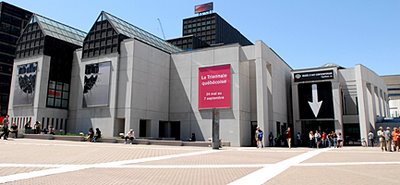Yokelist Manifesto Number 2
Montreal case study

How well do our institutions present art made here?
That’s a question that came to mind a few months back when I visited the Musée d'art contemporain de Montréal (pictured above), which had given most of its museum over to a five-decade retrospective of Montreal abstract painter Claude Tousignant.
He’s best known for his eye-popping, op-art target paintings from the ‘60s that are like Kenneth Noland on LSD (see below). But before I saw the show I’d never heard of him.
The museum touted the show as “the largest exhibition devoted to a single artist ever presented” there. It was evidence of Tousignant’s stature. “A leading light of abstraction,” the museum said. “Encompassing the range of modernist expression, Tousignant’s pictorial practice is unique in the history of Canadian art.”
A Boston gallerist gave me a blank look when I asked if he’d heard to Tousignant. Web searches of The New York Times and New York’s Museum of Modern Art archives turned up nothing.
Can you imagine Boston’s Museum of Fine Arts or Institute of Contemporary Art devoting “six of the museum’s eight galleries as well as the atrium” to a local artist that doesn’t exist as far as New York is concerned?
“There’s almost a lack of confidence and people don’t really fully appreciate what they have right under their noses,” Mark Lanctôt, who co-curated the Tousignant show with Paulette Gagnon, tells me.

He could be describing the Boston art scene, or numerous other “second cities,” but he was talking about Montreal. I called him to talk about showing locally-made art when your museum is outside the major international art centers – which for him are Paris, London and New York.
“We try to make sure what we pick and how we present it is at par with anything else,” Lanctôt says. “We don’t pick somebody because they’re here. We pick somebody because the level they’re working at internationally.”
But a significant difference between the Musée d'art contemporain de Montréal and major Boston museums is that it is a government-owned institution with a mandate to exhibit the best of Quebec art and the best Canadian art, as well as the best art from anywhere.
Lanctôt notes that when local artists show at the Musée it doesn’t open all the doors to, say, New York. But he finds that local artists “up their game” when they show there, the museum often acquires work from these exhibits, and the institution tries to produce more substantial catalogues for these shows.
Montreal – along with Toronto and Vancouver – is one of three major cultural centers in Canada. It is the largest city in the province of Quebec, and the second largest in the country. This dictates Montreal’s stature, influence and responsibility to its own artists. “In your country, you’re a capital, no matter what happens elsewhere,” Lanctôt says.
Perhaps that’s a lesson for the Boston art scene. Maybe our curators need to try acting like we’re a cultural capital.
Because of Boston’s geographical proximity to New York, our art scene often feels like a tiny satellite orbiting that bright star. Our curators are obsessed with its light. And, of course, they ought to be.
If you work in a Boston-area museum, your next job most likely won’t be around here. You climb the curatorial ladder by moving Away. And Away doesn’t give a shit about art made in Boston. In fact, Away thinks curators who pay much attention to Boston-made art are crazy.
All curators like to claim to have discovered artists, given them their first museum shows. But mainly what that entails these days is curators showing work by artists on the Circuit of jet-set art fairs and biennials and Chelsea galleries – art that everyone Away already agrees is worthwhile. If a Boston-area curator shows art made here, they’ll have to convince Away bosses that this local stuff is worthwhile. And championing an artist from scratch like that is a skill few seem to have.
Or perhaps it’s just too risky to a curator’s career.
Previously: Yokelist Manifesto Number 1.
Pictured from top to bottom: Musée d'art contemporain de Montréal and Claude Tousignant’s “Rythmique stochastique 2,” 1965, acrylique sur bois, 80.7 x 96.1 cm, collection Musée d'art contemporain de Montréal, don de monsieur Michel Touchette, photo by Richard-Max Tremblay © Claude Tousignant, 2005.

How well do our institutions present art made here?
That’s a question that came to mind a few months back when I visited the Musée d'art contemporain de Montréal (pictured above), which had given most of its museum over to a five-decade retrospective of Montreal abstract painter Claude Tousignant.
He’s best known for his eye-popping, op-art target paintings from the ‘60s that are like Kenneth Noland on LSD (see below). But before I saw the show I’d never heard of him.
The museum touted the show as “the largest exhibition devoted to a single artist ever presented” there. It was evidence of Tousignant’s stature. “A leading light of abstraction,” the museum said. “Encompassing the range of modernist expression, Tousignant’s pictorial practice is unique in the history of Canadian art.”
A Boston gallerist gave me a blank look when I asked if he’d heard to Tousignant. Web searches of The New York Times and New York’s Museum of Modern Art archives turned up nothing.
Can you imagine Boston’s Museum of Fine Arts or Institute of Contemporary Art devoting “six of the museum’s eight galleries as well as the atrium” to a local artist that doesn’t exist as far as New York is concerned?
“There’s almost a lack of confidence and people don’t really fully appreciate what they have right under their noses,” Mark Lanctôt, who co-curated the Tousignant show with Paulette Gagnon, tells me.

He could be describing the Boston art scene, or numerous other “second cities,” but he was talking about Montreal. I called him to talk about showing locally-made art when your museum is outside the major international art centers – which for him are Paris, London and New York.
“We try to make sure what we pick and how we present it is at par with anything else,” Lanctôt says. “We don’t pick somebody because they’re here. We pick somebody because the level they’re working at internationally.”
But a significant difference between the Musée d'art contemporain de Montréal and major Boston museums is that it is a government-owned institution with a mandate to exhibit the best of Quebec art and the best Canadian art, as well as the best art from anywhere.
Lanctôt notes that when local artists show at the Musée it doesn’t open all the doors to, say, New York. But he finds that local artists “up their game” when they show there, the museum often acquires work from these exhibits, and the institution tries to produce more substantial catalogues for these shows.
Montreal – along with Toronto and Vancouver – is one of three major cultural centers in Canada. It is the largest city in the province of Quebec, and the second largest in the country. This dictates Montreal’s stature, influence and responsibility to its own artists. “In your country, you’re a capital, no matter what happens elsewhere,” Lanctôt says.
Perhaps that’s a lesson for the Boston art scene. Maybe our curators need to try acting like we’re a cultural capital.
Because of Boston’s geographical proximity to New York, our art scene often feels like a tiny satellite orbiting that bright star. Our curators are obsessed with its light. And, of course, they ought to be.
If you work in a Boston-area museum, your next job most likely won’t be around here. You climb the curatorial ladder by moving Away. And Away doesn’t give a shit about art made in Boston. In fact, Away thinks curators who pay much attention to Boston-made art are crazy.
All curators like to claim to have discovered artists, given them their first museum shows. But mainly what that entails these days is curators showing work by artists on the Circuit of jet-set art fairs and biennials and Chelsea galleries – art that everyone Away already agrees is worthwhile. If a Boston-area curator shows art made here, they’ll have to convince Away bosses that this local stuff is worthwhile. And championing an artist from scratch like that is a skill few seem to have.
Or perhaps it’s just too risky to a curator’s career.
Previously: Yokelist Manifesto Number 1.
Pictured from top to bottom: Musée d'art contemporain de Montréal and Claude Tousignant’s “Rythmique stochastique 2,” 1965, acrylique sur bois, 80.7 x 96.1 cm, collection Musée d'art contemporain de Montréal, don de monsieur Michel Touchette, photo by Richard-Max Tremblay © Claude Tousignant, 2005.






1 Comments:
Gah! Thanks for ruining my day. Not that I didn't already know this.
Post a Comment
<< Home